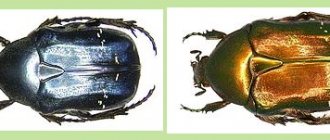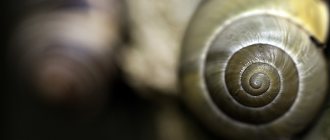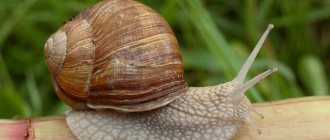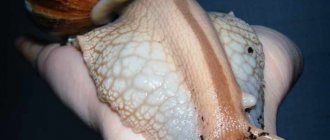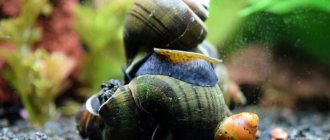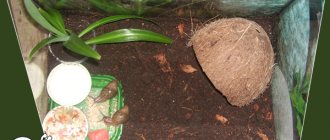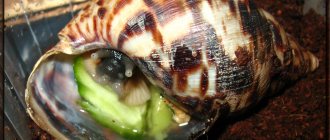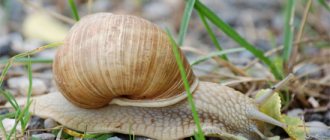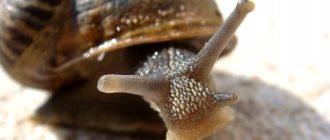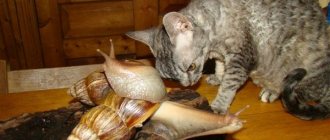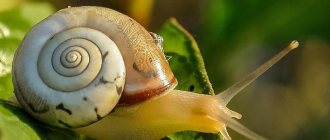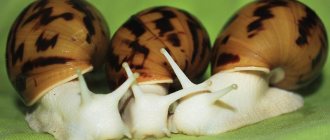If you find a very large brownish snail with a round shell and an elongated slimy body on a humus heap, grass or other damp places, then it will most likely be grape snail. For a long time I believed that such snails could only live in the warm south. But recently I saw them in the Tver region not far from the Ivankovo reservoir (Moscow Sea). Grape snails have also multiplied in Valdai. They are found in Moscow on the territory of the All-Russian Exhibition Center, the Timiryazev Academy and even in parks. Farms have appeared near Moscow where giant land-based mollusks are grown. Recently, there have been publications with such headlines as: “Grape snails are attacking the Moscow region,” “Grape snails are conquering the north,” “Let’s protect our gardens from grape snails.” Some people find this large mollusk so cute that they put it in a terrarium and keep it as a pet.
Grape snail
Torsion[ | ]
As a result of torsion, the visceral sac is rotated 180° counterclockwise. As a result, the shell curl turns out to be directed backward, and the edge of its growth and the mantle cavity are directed forward. Thus, the concha becomes endogastric. It is believed that torsion arose during the transition from a pelagic to a benthic lifestyle, since when existing in benthos, an exogastric (the curl is directed forward) pre-torsion shell is very inconvenient.
Torsion can be observed during the embryonic development of primitive gastropods such as the limpet
(Patellogastopoda). In this case, the larva unfolds its internal sac due to muscle effort. This process is called physiological torsion. However, in most modern species of gastropods, torsion is exclusively “evolutionary”, and in embryonic development the visceral sac is formed already rotated.
It should be noted that the group of opisthobranch mollusks is characterized by detorsion—rotation of the visceral sac by 90° in the opposite direction (clockwise).
Preparing for winter
Winter hibernation should be comfortable. To achieve this, the owner must make every effort. It is worth considering that the mollusk must accumulate nutrients. They will be able to maintain the life of the body during rest. Gastropods begin to look for shelter for the winter. If shelter cannot be found, then the snails begin to dig it out on their own. Minks are deep underground. Where the soil does not freeze. And the temperature remains at +7 degrees.
Gastropods begin to look for shelter for the winter
Many species go to winter in October. As a rule, they awaken with the onset of warmth - in the second half of April.
Turbo-spiral shell and asymmetry of the internal structure[ | ]
The structure of the pulmonary cochlea: 1 - shells;
2 - digestive gland; 3 - light; 4 - anus; 5 - pneumostomy; 6 - eye; 7 - tentacle; 8 - brain; 9 - radula; 10 - mouth; 11 - goiter; 12 - salivary gland; 13 - gonopore; 14 - penis; 15 - vagina; 16 - mucous gland; 17 - oviduct; 18 - bag of love arrows; 19 - leg; 20 - stomach; 21 - kidney; 22 - mantle; 23 - heart; 24 - vas deferens The appearance of the turbo-spiral shell is associated with the fact that this shape ensures its greatest strength with equal volume. It is believed that turbospirality is a key factor in the formation of asymmetry in the internal structure of gastropods. Thus, in gastropods with a saucer-shaped shell (family Fissurellidae within Archigastropoda), the internal structure is symmetrical, with the exception that the right kidney is larger than the left, and there is only one gonad - the right one (the latter is typical for all gastropods). When a turbo spiral occurs, the center of gravity of the shell shifts, and in order to restore its position, the shell must be shifted to the left. Such a displacement naturally causes a reduction in the right half of the internal organs, since, firstly, greater pressure is exerted on them, and, secondly, the flow of water through the mantle cavity becomes asymmetrical. Thus, in the families Haliotidae and Pleurotomariidae (Prosobranchia), the right ctenidium undergoes reduction. In the families Trochidae and Turbinidae (Prosobranchia), the right ctenidium is completely absent, and the right atrium is greatly reduced and does not bear a functional load. Finally, Caenogastropoda (the rest of the Prosobranchia) completely lack the right ctenidia, osphradium, hypobranchial gland and atrium. The left kidney becomes the main organ of excretion, and the right one is part of the reproductive system as the renal gonoduct (distal part of the reproductive ducts).
golden elephant
The homeland of this amazing snail is the Indonesian island of Sulawesi. Shellfish are common in Lake Poso and the Malili River. Individuals were brought to Europe by the Dutch in the 19th century. Since then, tilomelania have adapted to various conditions and began to be kept in the aquarium.
i1.wp.com
Tilomelania or rabbit snail is large in size. Its shell is conical, tapered, and reaches 12 cm in length. The shell may be smooth or have needle-like spines in the shape of curls. The body of snails is multi-colored:
- yellow;
- cream;
- orange;
- black with yellow or white spots.
The most common name is golden elephant, given to the individual due to its interesting structure. All specimens have a huge elongated trunk, incomparable to the size of the mollusk itself. It not only adds beauty to the snail, but is used by it to filter squeaks and search for prey.
You can keep a golden elephant in a spacious home aquarium. The main thing is to maintain optimal conditions, otherwise the individual will die.
Nervous system[ | ]
The nervous system of gastropods is of the scattered-nodular type. In most advanced representatives of this class, the nerve elements are concentrated at the anterior end of the body.
As a result of torsion in gastropods, the location of the visceral nerve trunks changes, and they form a cross - a visceral loop. As a result of this process, the initially right intestinal ganglion is located above the esophagus, and the left one is located below the esophagus. This phenomenon is called chiastoneuria.
However, in groups of opisthobranch and pulmonate snails, a return to the original plan of the structure of the nervous system occurs: in opisthobranchs due to detorsion, and in pulmonary snails due to a forward displacement of the ganglia.
There are 5 pairs of ganglia: cerebral (head), pedal (foot), pleural (mantle), parietal (respiratory), visceral (internal organs). Sense organs: eyes, osphradia, organs of touch, edges of the mantle.
Coming out of hibernation
The point regarding how snails sleep has been clarified. Now it remains to understand how they emerge from suspended animation. This process occurs after the soil at a depth of 10 cm warms up to +10 degrees.
During sleep they lose up to 30% of their weight
After the mollusk has emerged from the shell, it requires special care. It is worth offering food immediately. This will replenish the reserves of nutrients that have been used up. At such moments, snails can eat an amount of food that exceeds their body weight. When gastropods normalize their condition, they go in search of a partner for mating.
Respiratory system[ | ]
Breathing hole (pneumostome) in the mantle of the snail Lissachatina fulica var
hamillei
f.
rodatzi albino body
The initial respiratory organs are ctenidia. Their presence is characteristic of all Prosobranchia. Ctenidia are also present in Opisthobranchs, but in this group the respiratory function can be taken over by secondary gills (order Nudibranchs). In pulmonate snails, the ctenidium is completely reduced in the process of adaptation to life on land. Instead, a dense network of blood vessels develops in the mantle cavity. The mantle cavity itself is filled with air and has one opening that connects it with the external environment - a pneumostome. In those representatives of Pulmonary snails that transition to life in water for the second time, breathing occurs either during periodic ascents to the surface, or (in a small number of species) the mantle cavity is filled with water, that is, it works like gills, or secondary gills appear. In addition, some Pulmonary snails have a semblance of a tracheal system, that is, from the lung to all organs there are channels through which air is transported.
Reproduction[ | ]
Snails usually lay their eggs in special egg capsules. These capsules have a hard outer shell. So that the larvae can get out of the capsule, the capsule has a special cap - by the time the offspring is ready to leave the capsule, the cap falls off or dissolves. Snails usually lay eggs in large groups called clutches. If the capsules look like small glasses on legs, then they are arranged in rows in the masonry. If the capsules are oval, then the masonry looks like a lump. It often happens that there are no eggs in the capsules located at the edges of the clutch - a predator that attacks such a clutch will gnaw through several empty capsules and leave without causing any harm to the eggs.
Pelagic larvae called veliger hatch from the clutches of many sea snails. The veliger moves with the help of large blades or outgrowths covered with cilia. These cilia constantly vibrate, creating a flow of water, which allows the larvae to swim and also collect small particles of food. Veligers of some species can live in the water column for weeks. The veliger's sail gradually decreases, and the snail itself becomes more and more similar to an adult snail. Finally she falls to the bottom and begins to crawl.
For many snails, only a few snails (non-pelagic) mature in one clutch. The remaining eggs are needed only as food for young snails (trophic eggs). The more trophic eggs, the larger the snails emerging from the clutches will be. There are also viviparous snails.
The role of hibernation
Hibernation is a common phenomenon for gastropods. Sleep occurs mainly in unfavorable weather conditions. As a result, the vital activity of snails is significantly reduced.
Hibernation is a common phenomenon for gastropods
Snails are able to respond to:
- decrease in temperature;
- increase in temperature;
- drought;
- food shortage.
Diapause allows mollusks to survive unfavorable weather conditions. Awakening usually occurs after a few weeks. To prevent the pet from dying from exhaustion, it is fed generously before going to bed.
Diapause is important to gastropods for a number of reasons:
- Prevents drying out.
- Eliminates overheating during drought and heat.
- The animal does not freeze in winter.
- Affects the stimulation of reproduction.
Diapause allows mollusks to survive adverse weather conditions
Domestic snails must be properly prepared for awakening.
Classification[ | ]
The shell of Liguus virgineus
There are more than 400 known living families and about 200 extinct ones. In old systems, 4 subclasses of gastropods were distinguished:
- Opisthobranchia (opisthobranchia): pteropods
- Gymnomorpha (shellless)
- Prosobranchia (prosobranchia): limpets, livebearers, helmet snails, abalones
- Pulmonata (pulmonary): grape snail, coils, pond snails, slugs, amber snails
The system presented by Bouchet & Rocroi in 2005 takes into account the DNA structure of mollusks, and subordinate taxa lost their ranks - they were replaced by clades. The classification of gastropods according to this system is as follows:
- Clade Patellogastropoda
- Clade Vetigastropoda
- Clade Cocculiniformia
- Clade Neritimorpha (= Neritopsina) Clade Cyrtoneritimorpha
- Clade Cycloneritimorpha
- Architaenioglossa
- Clade Littorinimorpha
- "Lower Heterobranchia" (= Allogastropoda)
- Basommatophora
In 2022, a significantly updated version of this classification was published: “Revised Classification, Nomenclator and Typification of Gastropod and Monoplacophoran Families”[4].
Alternative classification[ | ]
The MolluscaBase electronic resource, associated with the World Register of Marine Species, offers the following classification of gastropods (up to order inclusive) as of September 2022[5]:
- †Superfamilies and families incertae sedis
- Subclass Caenogastropoda Cox, 1960 - Caenogastropoda Superfamilies and families incertae sedis
- Order Architaenioglossa Haller, 1890
- Order Littorinimorpha Golikov et Starobogatov, 1975
- Order Neogastropoda Wenz, 1938
- Subterclass Sorbeoconcha Ponder & Lindberg, 1997 Families incertae sedis
- †Superfamily Pseudozygopleuroidea Knight, 1930
- †Superorder Cerithiimorpha - 3 families
- †Superfamilies and families incertae sedis
- Order Aplysiida
- Order Cephalaspidea P. Fischer, 1883
- Order Pteropoda Cuvier, 1804 - Pteropods
- Order Runcinida
- ? Order Tectibranchiata
- Order Umbraculida Odhner, 1939
- Superorder Acochlidiimorpha - 2 superfamilies
- Superorder Eupulmonata Haszprunar & Huber, 1990 Order Ellobiida
- Order Stylommatophora A. Schmidt, 1855 - Stalk-eyed
- Order Systellommatophora Pilsbry, 1948 - Shellless
Basommatophora] - 2 superfamilies
- Order Siphonariida
- Order Cocculinida
- †Superfamilies incertae sedis
- Families incertae sedis
Grape snail mucus as a cosmetic product
Grape snails secrete a lot of mucus when moving. It is considered a good cosmetic product, so creams and serums are made based on it. Snail mucus restores damaged or inflamed skin, smoothes wrinkles and is an excellent moisturizer.
Some salons offer expensive skin rejuvenation procedures. To do this, they use grape snails that slowly move over the face and body. They say that in this way it is really possible to smooth out and significantly reduce the number of wrinkles.
Notes[ | ]
- Cuvier G.
Second mémoire sur l'organization et les rapports des animaux à sang blanc, dans lequel on traite de la structure des Mollusques et de leur division en ordres, lu à la Société d'histoire naturelle de Paris, le 11 Prairial, an III (French) // Magazin Encyclopédique, ou Journal des Sciences, des Lettres et des Arts. - 1795. - Vol. 2. - P. 433-449. - Biological encyclopedic dictionary / Ch. ed. M. S. Gilyarov; Editorial team: A. A. Baev, G. G. Vinberg, G. A. Zavarzin and others - M.: Sov. encyclopedia, 1986. - P. 83. - 831 p. — 100,000 copies.
- Higher taxa of animals: data on the number of species for Russia and the whole world
- Bouchet P., Rocroi J.-P., Hausdorf B., Kaim A., Kano Y., Nützel A., Parkhaev P., Schrödl M. and Strong EE
Revised Classification, Nomenclator and Typification of Gastropod and Monoplacophoran Families // Malacologia. — 2022. — Vol. 61, no. 1-2. — 1—526 s. - doi:10.4002/040.061.0201. - Gastropoda (English) in the MolluscaBase database. (Accessed: October 18, 2021).
- Life of animals. In 7 volumes/ch. ed. V. E. Sokolov. — 2nd ed., revised. - M.: Education, 1984. - T. 3: Arthropods: trilobites, chelicerates, trachein-breathing. Onychophora / ed. M. S. Gilyarova, F. N. Pravdina. - P. 51. - 463 p. : ill.
Literature[ | ]
- Fausek V. A.
Gastropods // Encyclopedic Dictionary of Brockhaus and Efron: in 86 volumes (82 volumes and 4 additional). - St. Petersburg, 1890-1907. - Ivanov A.V.
Class of gastropods // Guide to Zoology, vol. 2 - Invertebrates. - M.-L., 1940. - Likharev I.M., Rammelmeyer E.S.
Terrestrial mollusks of the fauna of the USSR. - M.-L.: Publishing House of the USSR Academy of Sciences, 1952. - 520 p. - Basics of paleontology. T. 4: Molluscs - gastropods / Team of authors; Ed. V. F. Pchelintseva and I. A. Korobkova. - M.: State Scientific and Technical Publishing House of Literature on Geology and Subsoil Protection, 1960.
- Beklemishev V.N.
Fundamentals of comparative anatomy of invertebrates: In 2 volumes / Rep. ed. L. A. Zenkevich. — 3rd ed., revised. and additional - M.: Nauka, 1964. - 432 p.; 448 p. — 4500 copies. - Dogel V. A.
Zoology of invertebrates: Textbook for un-tov / Ed. prof. Yu. I. Polyansky. — 7th ed., revised. and additional - M.: Higher School, 1981. - 606 p. — 50,000 copies. - Kantor Yu. I., Sysoev A. V.
Marine and brackish water gastropods of Russia and adjacent countries: illustrated catalog = Marine and brackish water Gastropoda of Russia and adjacent countries: an illustrated cataloque / Institute of Problems of Ecology and Evolution im. A. N. Severtsov RAS, Fundamental Research Program. Presidium of the Russian Academy of Sciences “Biodiversity and dynamics of gene pools”. - M.: Partnership of Scientific Publications KMK, 2006. - 371, [140] p. — ISBN 5-87317-292-7.
- Bouchet P. & Rocroi J.-P. (Ed.); Frýda J., Hausdorf B., Ponder W., Valdes A. & Warén A. 2005. Classification and nomenclator of gastropod families. Malacologia: International Journal of Malacology
47(1-2). ConchBooks: Hackenheim, Germany. ISBN 3-925919-72-4. 397 pp. - Paul Jeffery. 2001. Suprageneric classification of class Gastropoda. The Natural History Museum, London, 2001.
- Ponder W. & Lindberg DR 1997. Towards a phylogeny of gastropod molluscs; an analysis using morphological characters. Zoological Journal of the Linnean Society 119
: 83–265.
